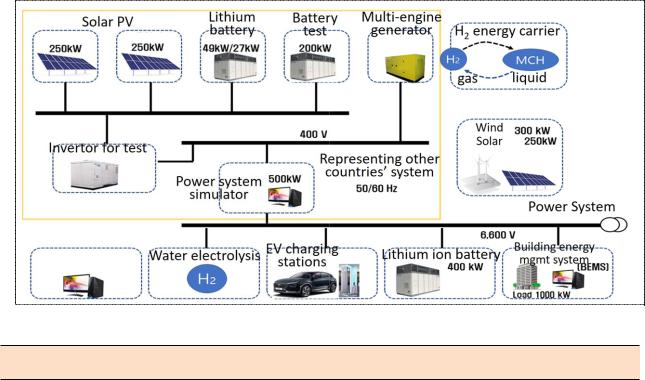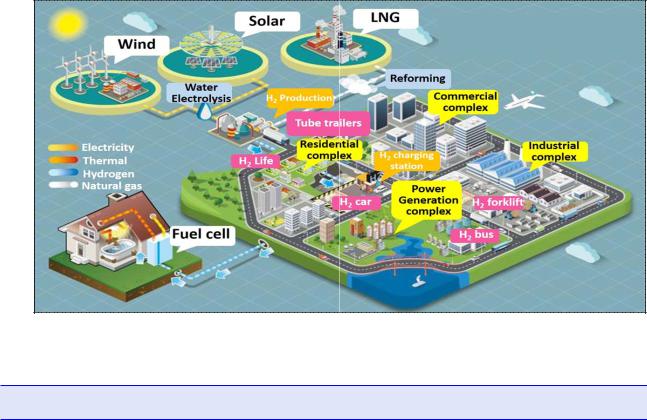
01 POWER ISLAND / 02 H2+NH3 / KOR-Hydrogen-Economy-Roadmap-of-Korea_REV-Jan19
.pdfSector |
Basic/Original (MSIT) |
Parts/Products (MOTIE) |
Support for Diffusion |
|||
|
|
|
|
(MOLIT & MOF) |
||
Production |
Alkaline, PAM water |
P2H technology |
Site provision |
|||
development and |
(abandoned roads, |
|||||
|
|
electrolysis technology, etc. |
demonstration |
etc.) |
|
|
|
|
|
|
|||
STO·TRANS |
-Lique faction |
Ultra-vacuum liquid |
Liquefaction tank lorry |
|
|
|
hydrogen storage, etc. |
and fueling technology |
Mass demonstration |
||||
Liquid |
Hydrogen → organic |
Transport technology for |
in central urban |
|||
compound (ammonia) |
areas |
|
||||
liquid organic compounds |
|
|||||
conversion |
|
|
||||
|
|
|
|
|
||
|
sion |
Electrode/catalyst materials |
Ship fuel cell |
Establishing |
|
|
|
manufacturing |
|
||||
Shipping |
Propul- |
|
infrastructure |
to supply |
||
TRANS |
Cryogenic insulation, |
Basic designs for |
||||
and store H2 |
in port |
|||||
unloading technology, etc. |
storage vessels, etc. |
|||||
|
|
|||||
Build a large-scale demonstration platform offering next-generation technologies and services.
Sector |
Expected Effects |
|
|
|
|
Main Content |
|
||
Hydrogen Fusion |
Increased |
▪ |
For |
hydrogen companies, research |
institutes, and |
||||
& Convergence |
|
other |
areas where infrastructure is |
concentrated |
|||||
industrial |
|
||||||||
Complex |
▪ Establish infrastructure, designate specialized |
||||||||
competitiveness |
|||||||||
(MOTIE) |
|
|
companies, train |
professional personnel, etc. |
|||||
Specialized |
Securing of |
▪ |
Demonstrate |
the |
production |
of hydrogen from |
|||
Demonstration |
leading |
|
biomass such |
as |
municipal |
waste |
|
||
technologies |
|
|
|||||||
|
|
|
|
|
|
|
|
||
Ensure safety throughout the entire value chain to ensure the reliability and stability of the hydrogen economy.
|
|
|
|
Major Content |
Fuel Cells & Parts of |
Prepare safety test and certification standards for fuel cell |
|||
Hydrogen |
products |
for |
power |
generation |
vehicles(FCEV) |
Improve |
the |
safety |
of vehicle parts and fueling systems, such |
(MOTIE) |
as storage vessels |
|
||
Hydrogen Trains and |
Establish safety verification and technical standards for the |
|||
Ships |
commercialization of hydrogen trains |
|||
- 57 -

Hydrogen Technology Roadmap (Plan)
Production
Storage
Transportation
Applications
Reform
electrolysis Water |
PEM Alkali |
|
Other
Gas
Liquef.
Solid
Liquid
Pipeline
TT
Tank lorry
Ships
vehicles(FCEV) Hydrogen |
|
stations |
Fueling |
|
|
trans |
Other |
cells Fuel |
|
Main Tasks |
Tech. Development→Commercialization (year) |
||||||||||||
19 |
20 |
21 |
22 |
23 |
24 |
25 |
26 |
27 |
28 |
29 |
30- |
||
|
|||||||||||||
Localize hydrogen extraction using natural gas and improve efficiency |
|
|
|
|
|
|
|
|
|
|
|
|
|
|
|
|
|
|
|
|
|
|
|
|
|
||
Secure high-capacity alkaline electrolysis technology |
|
|
|
|
|
|
|
|
|
|
|
|
|
|
|
|
|
|
|
|
|
|
|
|
|
||
Localize and standardize alkaline electrolytic parts |
|
|
|
|
|
|
|
|
|
|
|
|
|
|
|
|
|
|
|
|
|
|
|
|
|
||
|
|
|
|
|
|
|
|
|
|
|
|
||
Secure high-capacity polymer/water electrolytic technolog |
|
|
|
|
|
|
|
|
|
|
|
|
|
|
|
|
|
|
|
|
|
|
|
|
|
||
Localize and standardize polymer/water electrolytic parts |
|
|
|
|
|
|
|
|
|
|
|
|
|
|
|
|
|
|
|
|
|
|
|
|
|
||
Water electrolytic integration system technology linked with renewable energy |
|
|
|
|
|
|
|
|
|
|
|
|
|
|
|
|
|
|
|
|
|
|
|
|
|
||
Improve lifespan and power consumption of water electrolytic syste |
|
|
|
|
|
|
|
|
|
|
|
|
|
|
|
|
|
|
|
|
|
|
|
|
|
||
Commercialize water electrolyte-based hydrogen production |
|
|
|
|
|
|
|
|
|
|
|
|
|
|
|
|
|
|
|
|
|
|
|
|
|
||
Secure hydrogen production technology utilizing biomass such as waste |
|
|
|
|
|
|
|
|
|
|
|
|
|
|
|
|
|
|
|
|
|
|
|
|
|
||
Demonstrate large-scale hydrogen gas storage and transportation (450 bar) |
|
|
|
|
|
|
|
|
|
|
|
|
|
|
|
|
|
|
|
|
|
|
|
|
|
||
Develop high-pressure complex vessel for hydrogen fueling (900 bar↑) |
|
|
|
|
|
|
|
|
|
|
|
|
|
|
|
|
|
|
|
|
|
|
|
|
|
||
Develop designs related to hydrogen storage and transportation and core parts |
|
|
|
|
|
|
|
|
|
|
|
|
|
|
|
|
|
|
|
|
|
|
|
|
|
||
Develop solid hydrogen storage (tank lorry) technology for transportation |
|
|
|
|
|
|
|
|
|
|
|
|
|
|
|
|
|
|
|
|
|
|
|
|
|
||
Develop high-pressure gas-solid/liquid-solid hybrid storage technology |
|
|
|
|
|
|
|
|
|
|
|
|
|
|
|
|
|
|
|
|
|
|
|
|
|
||
Develop liquid compound materials and storage/transportation technolog |
|
|
|
|
|
|
|
|
|
|
|
|
|
|
|
|
|
|
|
|
|
|
|
|
|
||
Demonstrate liquid compound storage and transportation technology |
|
|
|
|
|
|
|
|
|
|
|
|
|
|
|
|
|
|
|
|
|
|
|
|
|
||
Establish short-distance piping infrastructure (within 10 km) |
|
|
|
|
|
|
|
|
|
|
|
|
|
|
|
|
|
|
|
|
|
|
|
|
|
||
Demonstrate hydrogen using piping for transportation |
|
|
|
|
|
|
|
|
|
|
|
|
|
|
|
|
|
|
|
|
|
|
|
|
|
||
Construct hydrogen supply piping (acquisition base-consumers) |
|
|
|
|
|
|
|
|
|
|
|
|
|
|
|
|
|
|
|
|
|
|
|
|
|
||
Develop ultra-high-pressure tube trailers (450, 900 bar) |
|
|
|
|
|
|
|
|
|
|
|
|
|
|
|
|
|
|
|
|
|
|
|
|
|
||
Develop transportation (tank lorry) low-pressure liquid hydrogen (3 bar) and fueling technology |
|
|
|
|
|
|
|
|
|
|
|
|
|
|
|
|
|
|
|
|
|
|
|
|
|
||
Construct liquid hydrogen storage/acquisition base |
|
|
|
|
|
|
|
|
|
|
|
|
|
|
|
|
|
|
|
|
|
|
|
|
|
||
Develop liquid Hydrogen carrier (utilizing LNG carrier building technology) |
|
|
|
|
|
|
|
|
|
|
|
|
|
|
|
|
|
|
|
|
|
|
|
|
|
||
R&D to improve safety related to collisions, rollovers, and fires |
|
|
|
|
|
|
|
|
|
|
|
|
|
|
|
|
|
|
|
|
|
|
|
|
|
||
Secure high-pressure hydrogen vessel and high-voltage converter technology for buses |
|
|
|
|
|
|
|
|
|
|
|
|
|
|
|
|
|
|
|
|
|
|
|
|
|
||
Analyze and improve the durability of parts by demonstrating hydrogen taxis |
|
|
|
|
|
|
|
|
|
|
|
|
|
|
|
|
|
|
|
|
|
|
|
|
|
||
Develop 5- to 10-ton hydrogen trucks |
|
|
|
|
|
|
|
|
|
|
|
|
|
|
|
|
|
|
|
|
|
|
|
|
|
||
Develop technology for localizing electric parts (inverters and converters) |
|
|
|
|
|
|
|
|
|
|
|
|
|
|
|
|
|
|
|
|
|
|
|
|
|
||
Localize core parts (compression high-pressure valve, storage container, etc.) and fueling technology |
|
|
|
|
|
|
|
|
|
|
|
|
|
|
|
|
|
|
|
|
|
|
|
|
|
||
Mass-produce parts and reduce core part prices (stack, platinum catalyst, H2 tank, etc.) |
|
|
|
|
|
|
|
|
|
|
|
|
|
|
|
|
|
|
|
|
|
|
|
|
|
||
Develop safety evaluation method for fueling stations and parts |
|
|
|
|
|
|
|
|
|
|
|
|
|
|
|
|
|
|
|
|
|
|
|
|
|
||
Improve hydrogen storage density (wt%) and minimize safety incidents |
|
|
|
|
|
|
|
|
|
|
|
|
|
|
|
|
|
|
|
|
|
|
|
|
|
||
Develop metropolitan hydrogen bus (charter bus) technology (design, motor, H2 vessel, etc.) |
|
|
|
|
|
|
|
|
|
|
|
|
|
|
|
|
|
|
|
|
|
|
|
|
|
||
|
|
|
|
|
|
|
|
|
|
|
|
||
Develop 1- to 2-ton hydrogen fueling technology per day |
|
|
|
|
|
|
|
|
|
|
|
|
|
|
|
|
|
|
|
|
|
|
|
|
|
||
|
|
|
|
|
|
|
|
|
|
|
|
||
Develop liquid hydrogen fueling station technology |
|
|
|
|
|
|
|
|
|
|
|
|
|
|
|
|
|
|
|
|
|
|
|
|
|
||
|
|
|
|
|
|
|
|
|
|
|
|
||
Develop high-pressure complex vessel for hydrogen fueling stations (900 bar↑) |
|
|
|
|
|
|
|
|
|
|
|
|
|
|
|
|
|
|
|
|
|
|
|
|
|
||
Develop and demonstrate core technology of hydrogen, fuel cells, and shops |
|
|
|
|
|
|
|
|
|
|
|
|
|
|
|
|
|
|
|
|
|
|
|
|
|
||
Improve hydrogen train efficiency and verify safet |
|
|
|
|
|
|
|
|
|
|
|
|
|
|
|
|
|
|
|
|
|
|
|
|
|
||
Develop technology for high-power fuel cells |
|
|
|
|
|
|
|
|
|
|
|
|
|
|
|
|
|
|
|
|
|
|
|
|
|
||
Localize all parts of fuel cells for power generation and standardize |
|
|
|
|
|
|
|
|
|
|
|
|
|
|
|
|
|
|
|
|
|
|
|
|
|
||
Commercialize hydrogen generation using by-product hydrogen |
|
|
|
|
|
|
|
|
|
|
|
|
|
|
|
|
|
|
|
|
|
|
|
|
|
||
Improve lifespan and efficiency of parts for homes and buildings |
|
|
|
|
|
|
|
|
|
|
|
|
|
|
|
|
|
|
|
|
|
|
|
|
|
||
Develop IoT-linked products to maximize fuel and heat utilization |
|
|
|
|
|
|
|
|
|
|
|
|
|
|
|
|
|
|
|
|
|
|
|
|
|
||
Develop and localize hydrogen gas turbine technology |
|
|
|
|
|
|
|
|
|
|
|
|
|
|
|
|
|
|
|
|
|
|
|
|
|
||
Develop fuel cell manufacturing auto. technology for power generation |
|
|
|
|
|
|
|
|
|
|
|
|
|
|
|
|
|
|
|
|
|
|
|
|
|
||
|
|
|
|
|
|
|
|
|
|
|
|
|
|
- 58 -

2. Training of Specialists: In Response to the Expansion of the New Hydrogen Market
Training of safety manpower: Establishment and operation of training programs
Establish a national professional qualification (hydrogen safety manager (tentative
title) who effectively manages the safety of hydrogen across all processes, including hydrogen production, transportation, and supply.
*Promote content on the provision of a specialized qualification examination for the Hydrogen Safety Law.
Train hydrogen fueling station managers responsible for station design, operation, and safety management.
* Establish the “Hydrogen Fueling Station Manager” course (tentative title) and offer it at educational institutions or commission it to the Gas Safety Corporation.
Establish and operate a training course focused on conducting safety inspections in the parts (storage vessels) design and production stages.
*Establish and offer commissioned education or specialized courses on containers and special facilities.
Train core technology development personnel:
Operate support program for personnel with MA/PhD degrees
Support the dispatch and recruitment of the specialized personnel needed to upgrade the technology of SMBs.
*Currently, the Technological Innovation Small & Medium Business Researcher Support Project is supporting companies by dispatching the research personnel of public research institutes to SMBs (once per company for up to three years) and supporting SMBs in their efforts to recruit research staff (1 to 2 researchers per company for up to three years).
Production: Water electrolysis technology (KIER, KIST-SMBs [EMS, Elkemteg, etc.]) Storage: Advanced liquefaction/liquid technology (KIST, KIMM-SMBs [MetaVIsta, Hylium, etc.)
- 59 -

Establish education programs on the design, production, and maintenance of hydrogen fuel cells to stabilize the supply and demand of personnel in the hydrogen industry
(Hydrogen vehicles(FCEV)) Operate education programs based on partnership between manufacturing companies and polytechnics (including Meister high schools).
(Fuel |
Cells) Operate cooperative internship programs between manufacturing companies |
and |
universities. |
3. Preceding International Standards: Leading of the Global Market
Proposal of international standards: Increase of 13 cases by 2030 (20 percent)
*ISO/TC197 (hydrogen technology), IEC/TC105 (fuel cells), GTR (Global Technical Regulation), etc.
Hydrogen Technology: Propose two cases by 2022 → more than five in total by 2030
Content Main
Hydrogen Manufacturing
Evaluation of the performance and safety of large-scale extractors (300m3/hour) (by 2022) Evaluation of the performance and safety of high-efficiency
electricity/thermal/hydrogen-production system based on fuel cells (by 2030)
Storage Vessel
Evaluation of Type 3 and 4 storage vessels* of fueling stations (by 2030)
*Type 3: vessels wrapped with carbon fiber in metal
Type 4: vessels wrapped with carbon fiber in non-metallic material
Fueling System
Evaluation of the comprehensive performance and safety of hydrogen fueling system (by 2022) Evaluation of the performance and safety of portable hydrogen fueling stations (by 2025)
Fuel Cells: Propose three cases by 2022 → more than 10 in total by 2030
Content Main
For Construction Equipment
Three cases, including the general requirements and performance evaluation of the power system of fuel cells for construction equipment, such as excavators and trucks (by 2022)
For Transportation
Four cases, including general requirements and performance/safety evaluation of (portable) fuel cells for transportation, such as drones, ships, and trains (by 2030)
Next-generation Technology
Three cases, including next-generation, high-efficiency performance evaluation required for the revision of international standards for fixed/micro-type fuel cells (by 2030)
- 60 -

Leading of International Standardization
Promote strategic international standardization by reviewing and
proposing international standards and developing a roadmap to support industries through the operation of departments* at the Hydrogen Economy Standard Forum (launched in December 2018).
*Policies, hydrogen technology (manufacturing, storage, and fueling), and fuel cells (for power generation and transportation)
-Link with R&D projects related to the establishment of the hydrogen economy and support industrial responses to international standardization.
Expand industrial participation through international seminars and forums and establish a standard system for cooperation among Korea,
China, and Japan.
*In accordance with the terms of the international standard proposal, more than five countries must agree to participate in the working group.
4.Establishment of Basis for Hydrogen Economy: Promotion System and Support Organization
Cross-ministerial promotion system for the hydrogen economy
(Constitution) Establish and operate the cross-ministerial Hydrogen Economy Promotion Committee* as a general policy/coordination institution linked to hydrogen economy-related laws.
*Chairman: Prime Minister / Commissioners: Ministers and private experts
(Necessity) : To implement a roadmap for various government ministries at an early stage and achieve results, it is necessary to have a system for promoting cooperation between ministries and agencies.
- 61 -

- Discuss and coordinate the direction of the hydrogen economy implementation policy, roles and cooperation plans among ministries, implementation targets
(technology development, infrastructure, industrial ecosystem, etc.) and deregulation.
(Support System) : It will be launched within the Ministry of Industry first, and its expansion to a cross-ministerial system will be reviewed in consultation with other relevant authorities, considering the future
demand |
for policy. |
* Enact or |
revise laws and regulations, relax regulation, secure support budget, expand |
applications in terms of transportation and energy use, build infrastructure (such |
as |
hydrogen |
|||||
production, storage, |
transportation, |
and fueling |
stations), and conduct |
technology |
development |
||
and |
demonstrations. |
|
|
|
|
|
|
- A |
review will |
also be |
conducted |
to establish a |
specialized |
agency |
|
dedicated to fostering the hydrogen economy in the mid to long term.
*The Hydrogen Convergence Alliance, a public-private consultation body, was established in 2016, but its activities are currently limited. Some other institutions, such as the Korea Energy Agency and Energy Technology Institute, are sharing the responsibility for management functions.
Consider establishing the Hydrogen Distribution Center as well
(Purpose) Establish a fair and efficient distribution system by ensuring the stable supply and demand of hydrogen.
(Main functions) manage hydrogen supply and demand, logistics, and information and provide information on supply and demand trends and price difference by region of hydrogen available for sale.
Creation of hydrogen industrial cluster (2021)
(Purpose) Establish clusters, |
companies, and research institutes related |
|
to all parts of the |
value |
chain, including hydrogen production, |
storage, transportation, |
and utilization. |
|
*Ex: renewable energy, water electrolysis, next-generation fuel cells (for households/buildings and power generation), Hydrogen vehicles(FCEV) and drones, railroads, etc.
-62 -

(Main function) Develop technology throughout entire hydrogen industry and operate large-scale demonstration test bed.
-Establish hydrogen production and storage/transportation infrastructure in the cluster and perform R&D and large-scale demonstrations.
*From planning to R&D on demonstration complex design (total budget: KRW 2 billion / March 2019 to August 2020)
Hydrogen City composition: three pilot cities (by 2022)
(Purpose) create hydrogen cities by establishing distributed heat-electricity networks using hydrogen.
- Minimize the construction of backbone networks in urban areas by installing a distributed heat and power network based on hydrogen and achieve heat and electricity supply and demand stability by complementing intermittency.
(Construction strategy) After the pilot |
city project is completed, cities |
|
will be transformed to allow them to |
utilize |
hydrogen in all possible |
areas, such as residential, industrial, and |
traffic. |
|
- 63 -

-Expanding hydrogen production, storage, transportation, and utilization of Hydrogen vehicles(FCEV), fuel cells, and hydrogen mega stations to the actual city.
-Designing Hydrogen pilot cities (June 2019) → Review the condition of hydrogen production/supply and acceptability by end of 2019 → Selected the 1st pilot city (end of 2019) → will select the 2nd pilot city (2020)
5.Enact Laws: Institutional Base for Systematic Hydrogen Industry
The Hydrogen Economy Act will be enacted in the second half of 2019.
*A number of bills related to the hydrogen economy have been passed recently.
Reflect the overall regulations of the hydrogen industry, including the establishment of basic plans for the hydrogen economy, provision of support for hydrogen companies,* and improvement of regulations and safety management standards.
*Leading hydrogen-related SMBs and middle-standing companies → Provide multilateral support for R&D, commercialization, human resources, taxation, financing, etc.
-64 -

<Main Content of Hydrogen Economy Act (Plan) >
▪Establish five-year basic and annual plans for transition to a hydrogen economy-based society.
▪Recommend improvement of relevant laws.
(Ministry of Industry → heads of central agencies)
▪Support hydrogen companies (subsidies, taxation, etc.), designate specialized complexes, promote fueling station installation, train personnel, etc.
▪Establish safety management regulations for hydrogen-related products and facilities, safety registration, and licensing standards for operators.
6.Leading of Global Hydrogen Economy: Strategic International Cooperation
Establishment of global hydrogen economic cooperation network
Enhance partnerships with global companies by actively participating in international cooperation organizations, such as the International Partnership for Hydrogen and Fuel Cells in the Economy (IPHE) and the Hydrogen Council.
Secure leadership of global hydrogen economy by strengthening cooperation between interested countries.
* Strengthen exchange and cooperation among the certification bodies of the three countries and establish an international standardization response system.
Strengthening of cooperation for establishment of overseas hydrogen import base
Produce hydrogen overseas by utilizing overseas resources such as solar power and wind power in the Middle East, and Central and South America and transport the
hydrogen to the domestic market.
* Korea-Australia Resource Collaboration (ministerial-level) will work to establish a channel of cooperation for hydrogen projects and coordinate agendas.
(Co-develop water electrolysis technology → Demonstrate at large-scale renewable energy complex)
- 65 -

Expansion of technical cooperation by sector and value chain of hydrogen economy
Production, storage, and transportation: Develop water electrolysis technology, carbon capture technology for LNG extraction-type hydrogen production base, and mediumand large-scale liquid hydrogen production plant technology.
Hydrogen utilization: Implement technical cooperation to global market, develop/demonstrate hydrogen gas turbine technology, etc.
7. Establishment of Infrastructure for Export Industrialization: Hydrogen Korea
Public and private Hydrogen vehicles(FCEV) export capacity
Support exports by developing optimal package models for Hydrogen vehicles(FCEV) (buses, trucks, and taxis) and hydrogen infrastructure (production, transportation, and fueling) in emerging countries.
*Support the acquisition of international funds, such as the AIDB, in order to secure the funds needed to develop such package models.
Expand the case of patent sharing among automobile companies.
Overseas advancement of fuel cells and parts materials
Advance into overseas power generation markets in cooperation with public development corporations with low-cost fuels such as by-product hydrogen (small/medium) and flare gas.
Promote projects to secure the Track-Record, which guarantees the
reliability of domestic fuel cells, in connection with overseas technology development and demonstration projects and export products.
* Domestic: Support the joint equipment development and evaluation center for testing, demonstrating, and evaluating fuel cell components and systems → Track Record (domestic and overseas) → export (overseas)
- 66 -
